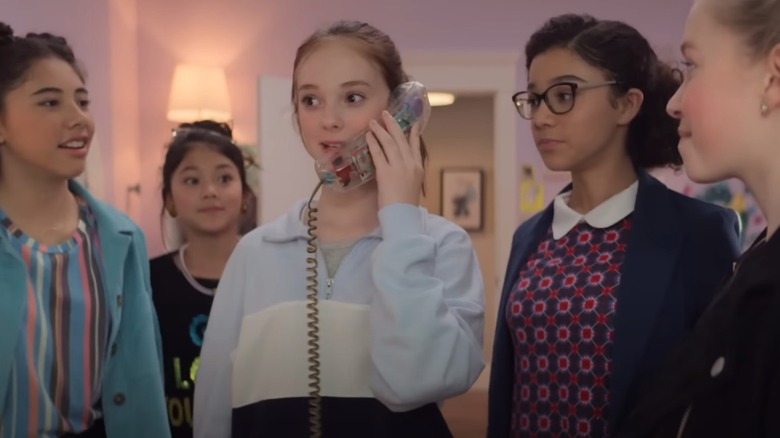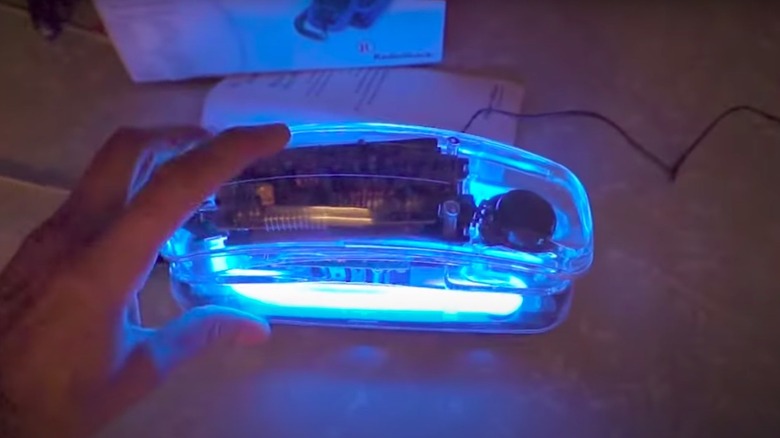Why The '90s Clear Phones Became So Popular
In the late 1980s, two forces converged to pave the way for the Conair Clear Phone: The 1982 government breakup of AT&T's monopoly on the phone industry and the recent developments in clear plastic manufacturing. Meanwhile, the phone's "trimline" design — putting the keypad or dial on the handset — increased the allure. The corded Conair Clear phone is just one of many products from what's now called the "clear craze," alongside see-through Nintendo Game Boys and Apple iMacs. Add to that the vagaries of teenage tastes, and a bonafide hit product was born. Conair's phone even lit up — what's not to like?
Yes, that's right — before the advent of the cell phone, Conair's Clear Phone and its imitators were in-demand status items throughout the 1990s, and they're still sought after today. Nowadays, though, clear phones with their electronic guts on display are more than collector's items: They're symbols of the era, used in TV shows and movies like the modern-day Netflix reboot, "The Baby-Sitters Club" (seen above).
Explaining the clear phone appeal, Rhode Island School of Design (RISD) instructor Matthew Bird told Slate in 2020 that it's about more than just transparency. "[I]t was taking a serious phone that was designed as, you know, an office phone, and it made it into a teenager phone," he said. "When you take something that was stuffy and make it fun, it shifts it."
Weird phones were in
Before clear phones were all the rage, AT&T monopolized the phone business, and it was more than just your phone service provider: The company, also known as Ma Bell, rented phones to most people, too, as The Washington Post reported in 1983. After AT&T was dismantled, a free-for-all in new and unusual phone designs followed. Clear phones were just one new design among many. At that time, there were also hamburger, banana, and football-shaped phones — and even Barbie and Garfield brand designs.
In 2020, one-time Conair CEO Barry Haber, formerly of Conair's consumer electronics division, told Slate, "In the phone business, you have to understand that after the phones were deregulated, the industry went from one company, AT&T, being our phone supplier, to two years later, there were over 300 companies supplying telephones."
Clear phones weren't an original idea at Conair, which was typically a maker of beauty electronic devices like hairdryers. According to Mental Floss, the Los Angeles Times' 1988 Disneyland guide listed a clear phone sold at the Premiere Shop in Tomorrowland. But Haber thought with just a few changes, existing clear phone designs could be marketed to young women — Conair's target demographic.
There were imitators
No one seems to remember exactly when the Conair Clear Phone was released — not even former Conair CEO Barry Haber — but once they were on the market, Conair sold between 2 and 3 million in five years. Anthony Solomita, who worked on the product for Conair at the time, told Slate, "Once we got it placed on the shelf, the sell-through was fantastic. ... It was probably one of the most widely distributed telephones we ever had." Soon, other brands wanted in on the action, including Guess, Swatch, Lonestar, and Unisonic — and don't forget the RadioShack neon trimline phone (above), which lit up even brighter than the Conair when it rang. Still, it's the Conair Clear Phone that most people think of today.
Nowadays, corded phones are essentially a thing of the past, but clearly, transparent electronics maintain their appeal. In May 2023, Digital Trends called for Apple to release a transparent iPhone. The patent, after all, has been registered, and in 2023 Beats — which Apple acquired in 2014 — referenced the "clear craze" in their transparent Beats Studio Buds+.

